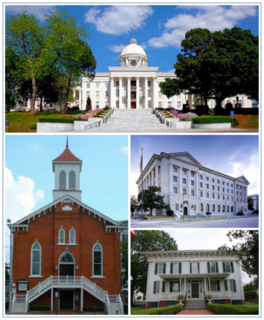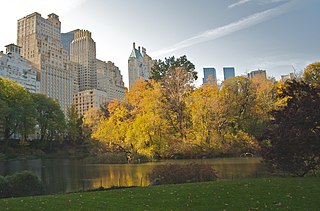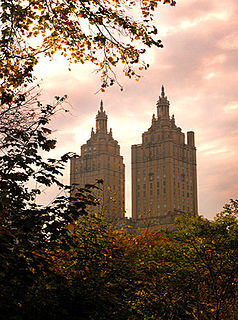
Montgomery is the capital city of the U.S. state of Alabama and the county seat of Montgomery County. Named for Richard Montgomery, it stands beside the Alabama River, on the coastal Plain of the Gulf of Mexico. In the 2020 Census, Montgomery's population was 200,603. It is the third most populous city in Alabama, after Birmingham and Huntsville, and is the 119th most populous in the United States. The Montgomery Metropolitan Statistical Area's population in 2020 was 386,047; it is the fourth largest in the state and 142nd among United States metropolitan areas.

An apartment, or flat, is a self-contained housing unit that occupies part of a building, generally on a single story. There are many names for these overall buildings, see below. The housing tenure of apartments also varies considerably, from large-scale public housing, to owner occupancy within what is legally a condominium, to tenants renting from a private landlord.

The San Remo is a luxury 27-floor co-operative apartment building at 145 Central Park West, between West 74th and 75th Streets, on the Upper West Side of Manhattan in New York City. Opened in 1930, the San Remo is described by Glen Justice of the New York Times as "a dazzling two-tower building with captivating views of Central Park." As a housing cooperative, its board has a reputation for "lenient admissions standards" compared to the conservative, old-money boards on the other side of the park.

Lafayette Park is a historic urban renewal district east of Downtown Detroit and contains the largest collection of residential buildings designed by Ludwig Mies van der Rohe. The northern section planned and partially built by Mies is listed in the National Register of Historic Places. In 2015 it was designated a National Historic Landmark District. Lafayette Park is located on the city's lower east side directly south of the Eastern Market Historic District. In general, the neighborhood, including portions developed by other architects, has been regarded as an incubator of progressive architecture and one of the few historically stable urban renewal zones in the United States.

Washington Highlands is a residential neighborhood in Southeast Washington, D.C., in the United States. It lies within Ward 8.

Frederick William ("Fred") Anhalt was a builder and contractor who constructed many distinguished rental apartment buildings in Seattle, Washington in the 1920s and early 1930s. In 1993, the Seattle Chapter of the American Institute of Architects (AIA) awarded Anhalt an honorary membership in recognition of excellence in residential design. In 2001, The Seattle Times listed Anhalt as one of the 150 most influential people in Seattle History His buildings have been referred to as "Castles in Seattle."

Lockefield Gardens was the first public housing built in Indianapolis. Constructed during the years 1935 to 1938, it was built exclusively for low income African-Americans in Indianapolis. The complex was closed in 1976, and a number of structures were demolished in the early 1980s. The only original structures remaining are those along Blake Street.

The Alwyn Court, also known as The Alwyn, is an apartment building at 180 West 58th Street, at the southeast corner with Seventh Avenue, in the Midtown Manhattan neighborhood of New York City. The Alwyn Court was built between 1907 and 1909 and was designed by Harde & Short in the French Renaissance style. It is one of several luxury developments constructed along Seventh Avenue during the late 19th and early 20th century.

The Roanoke Apartments, also known as the Terrace Apartments, is an apartment complex listed on the National Register of Historic Places located at 1402 Maiden Lane in the Raleigh Court neighborhood of the independent city of Roanoke, Virginia, U.S.A. Designed by James F. Mactier and constructed by Paul A. Wood, the complex features seven separate buildings, each with brick facades, and is Roanoke's best example of the streamline moderne style developed in the early 1950s. Today the complex is noted for its ethnic diversity with its residents representing a wide array of religious and ethnic groups.

The Cass–Davenport Historic District is a historic district containing four apartment buildings in Detroit, Michigan, roughly bounded by Cass Avenue, Davenport Street, and Martin Luther King, Jr. Boulevard. The district was listed on the National Register of Historic Places in 1997. The Milner Arms Apartments abuts, but is not within, the district.

The River Terrace Apartments is an apartment building located at 7700 East Jefferson Avenue in Detroit, Michigan. It was listed on the National Register of Historic Places in 2009. River Terrace Apartments was one of the first two garden apartment complexes built in Michigan which used loan guarantees from the Federal Housing Administration, the other being Hillcrest Village in East Lansing.

The Cleveland Court Apartments 620–638 is a historic apartment building in the Cleveland Court Apartment Complex in Montgomery, Alabama. It is significant to the history of the modern Civil Rights Movement in the United States. Unit 634 was home to civil rights activist Rosa Parks, her husband Raymond, and her mother, Leona McCauley, during the Montgomery bus boycott from 1955 to 1956. The building was placed on the Alabama Register of Landmarks and Heritage on March 30, 1989 and the National Register of Historic Places on October 29, 2001.

The Osborne, also known as the Osborne Apartments or 205 West 57th Street, is an apartment building at Seventh Avenue and 57th Street in Midtown Manhattan in New York City. The Osborne was originally designed by James Edward Ware and constructed from 1883 to 1885. An annex to the west, designed by Alfred S. G. Taylor and Julien Clarence Levi, was constructed in 1906. The Osborne is the second oldest luxury apartment building in New York City, behind the Dakota.

The Strathmore Apartments is a historic 8-unit multi-family complex located at 11005-11013 1/2 Strathmore Drive in the Westwood neighborhood of Los Angeles, California. Notable past residents, amongst others, include John Entenza, Charles Eames, Ray Eames, Luise Rainer, Clifford Odets, and Orson Welles.
Andrew Jackson Thomas (1875–1965) was a self-taught American architect who was known for designing low-cost apartment complexes that included green areas in the first half of the twentieth century.

998 Fifth Avenue is a luxury cooperative on the Upper East Side of Manhattan, New York City located on Fifth Avenue at the northeast corner of East 81st Street.

Michael Maltzan is the principal architect at Michael Maltzan Architecture (MMA), a Los Angeles-based architecture firm. He received a Master of Architecture degree from Harvard University and both a Bachelor of Architecture degree and a Bachelor of Fine Arts degree from the Rhode Island School of Design. Maltzan was selected as a Fellow of the American Institute of Architects in 2007.

The University Apartments, also known as the University Park Condominiums, are a pair of ten-story towers in Chicago, Illinois designed by I. M. Pei and Araldo Cossutta. The project was part of a city initiative to revitalize residential development in Hyde Park just north of the University of Chicago. Within the Hyde Park neighborhood, they are colloquially known as "Monoxide Island."

Arsenal Courts, also known as Century Woods, is a nationally recognized historic district located in Rock Island, Illinois, United States. It was added to the National Register of Historic Places in 2020. At the time of its nomination it consisted of 43 resources, all of them contributing buildings.





















